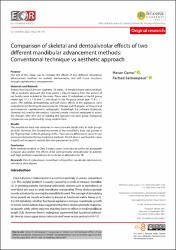| dc.contributor.author | Camcı, Hasan | |
| dc.contributor.author | Salmanpour, Farhad | |
| dc.date.accessioned | 2022-07-19T13:33:29Z | |
| dc.date.available | 2022-07-19T13:33:29Z | |
| dc.date.issued | 2022 | en_US |
| dc.identifier.citation | CAMCI, H., & Salmanpour, F. Comparison of skeletal and dentoalveolar effects of two different mandibular advancement methods: Conventional technique vs aesthetic approach. European Oral Research, 56(2), 96-101. | en_US |
| dc.identifier.issn | 2651-2823 | |
| dc.identifier.uri | https://doi.org/10.26650/eor.2022939871 | |
| dc.identifier.uri | https://hdl.handle.net/20.500.12933/1379 | |
| dc.description.abstract | Purpose: The aim of this study was to compare the effects of two different mandibular advancement methods on skeletal, dentoalveolar, and soft tissue structures through cephalometric measurements. Materials and methods: Twenty-four Class II division 1 patients (10 males, 14 female) treated with twin block (TB) or aesthetic approach (EA: Essix plates + Class II elastics) from the archive of our faculty were included in the study. There were 12 individuals in the EA group (mean age: 12.2 ± 1.0) and 12 individuals in the TB group (mean age: 11.8 ± 1.1 years). The skeletal, dentoalveolar, and soft tissue effects of the appliances were evaluated by performing 24 measurements, 12 linear and 12 angular, on the pre and post-treatment cephalometric radiographs. AudaxCeph 5.0 software (Ljubljana, Slovenia) was used for the analysis. A paired sample t-test was employed to assess the changes after one year of utilizing the appliance for each group. Intergroup comparison was performed by using student t test. Results: The mandibular base was observed to move forward significantly in both groups (p<0.05). However, the forward movement of the mandibular base was greater in the TB group than in the EA group (p<0.05). There was no difference in lower incisor protrusion between the two treatment methods. The EA device was found to cause a significant increase in vertical direction parameters (p<0.05). Conclusion: Both methods resulted in Class II malocclusion correction as well as an acceptable occlusion plus profile. The effects of EA were primarily dentoalveolar. In patients with high aesthetic expectations, EA could be an alternative for TB. | en_US |
| dc.language.iso | eng | en_US |
| dc.publisher | The Journal of Istanbul University Faculty of Dentistry | en_US |
| dc.relation.isversionof | 10.26650/eor.2022939871 | en_US |
| dc.rights | info:eu-repo/semantics/openAccess | en_US |
| dc.subject | Class II malocclusion | en_US |
| dc.subject | Mandibular retrognathia | en_US |
| dc.subject | Mandibular advancement | en_US |
| dc.subject | Twinblock | en_US |
| dc.subject | Clear aligners | en_US |
| dc.title | Comparison of skeletal and dentoalveolar effects of two different mandibular advancement methods: Conventional technique vs aesthetic approach | en_US |
| dc.type | article | en_US |
| dc.authorid | 0000-0003-0824-4192 | en_US |
| dc.authorid | 0000-0003-1006-9792 | en_US |
| dc.department | AFSÜ, Diş Hekimliği Fakültesi, Klinik Bilimler Bölümü | en_US |
| dc.contributor.institutionauthor | Camcı, Hasan | |
| dc.contributor.institutionauthor | Salmanpour, Farhad | |
| dc.identifier.volume | 56 | en_US |
| dc.identifier.issue | 2 | en_US |
| dc.identifier.startpage | 96 | en_US |
| dc.identifier.endpage | 101 | en_US |
| dc.relation.journal | European Oral Research | en_US |
| dc.relation.publicationcategory | Makale - Uluslararası Hakemli Dergi - Kurum Öğretim Elemanı | en_US |
















